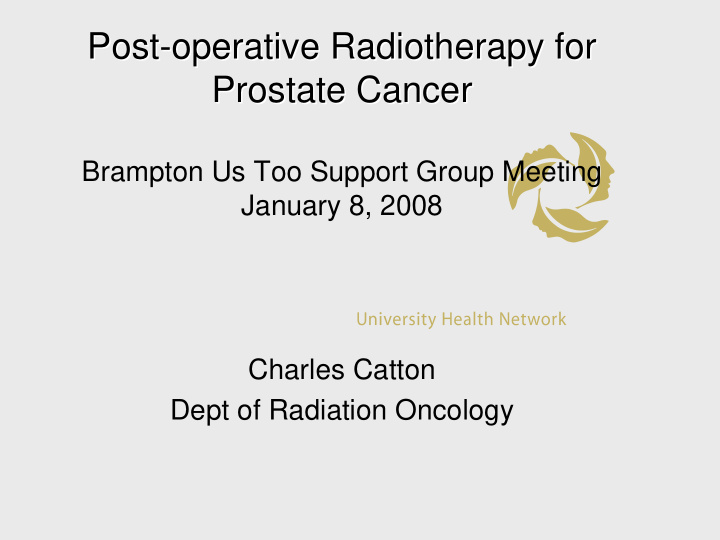



Post- -operative Radiotherapy for operative Radiotherapy for Post Prostate Cancer Prostate Cancer Brampton Us Too Support Group Meeting January 8, 2008 Charles Catton Dept of Radiation Oncology
Background: Prostate cancer Background: Prostate cancer 2 main curative treatments � Surgery � Radiotherapy
Background: Prostate cancer Background: Prostate cancer � Traditionally either one or the other. � Now starting to realize that there may be advantages to combining different therapies. � Each treatment has its own advantages and disadvantages. � One practical advantage of surgery is that you obtain additional information about the cancer by examining the removed prostate.
Tumour in extraprostatic soft tissue Seminal vesicle invasion
Negative Margin
Focally Positive Margin – tumour touching ink
Diffusely Positive Margin
Post- -operative PSA level operative PSA level Post After Radiation: Prostate still present. � PSA low, but not necessarily 0, and can fluctuate a bit without indicating cancer. After Surgery: Prostate gone. � If cancer also gone, PSA should be 0. � A rising PSA after surgery is a strong indicator that cancer still present.
Predicting the future Predicting the future � After surgery, we have new information from the pathologist and from PSA levels about the success of the treatment and the likely state of the prostate cancer at that time. � How do we use this information?
Predicting the future Predicting the future � In the past, we filed it away for future reference. Johns Hopkins Baltimore: Pound, C. R. et al. JAMA 1999;281:1591-1597.
Predicting the future Predicting the future � An elevated PSA after surgery predicts for future problems in a high proportion of men- often many years after the fact. � A positive margin is often associated with an elevated PSA after surgery. � Not sure what the significance is if the margin is positive but the PSA is not elevated.
What to do about it? What to do about it? 1. Wait and see what happens. 2. Give additional treatment to try to kill the remaining cancer cells. � The most practical treatment we have available is post-operative radiotherapy. � This will only work if the cancer cells are localized to the area near where the prostate was.
Radiation Planning- Immobilization Supine position with Vac-Loc device Prone position with Hip-fix device
Radiation Planning- CT simulation
Radiation Planning- beams and shielding • Planners use Planners use • software to software to visualize target visualize target and normal tissues and normal tissues in 3D in 3D • Shape beams and Shape beams and • shields shields
Radiation Delivery- -Image Guidance Image Guidance Radiation Delivery Cone-beam CT (CBCT) + soft tissue
Post- -Operative Radiotherapy Operative Radiotherapy Post � 2 trials of post-operative therapy started in the early-mid 1990’s � Both trials identified those with positive margins, and either treated with radiation or waited for a problem. � PSA test was not well-developed at the time, and could not read very low levels <0.3, so we do not know what the post-operative PSA levels were on most of the patients.
Post- -Operative Radiotherapy Operative Radiotherapy Post Results: Radiotherapy immediately after surgery reduced the risk of cancer recurrence based on PSA. � from 77% to 53% @ 10 years (US study) � from 50% to 20% @ 5 years (European study)
Post- -Operative Radiotherapy Operative Radiotherapy Post Results: � It appears that post-operative radiotherapy improves the cure rate for men with positive margins after surgery. � Should all men with positive margins receive post- operative radiotherapy?
Post- -Operative Radiotherapy Operative Radiotherapy Post Limitations: � Not all men with positive margins developed cancer recurrence after up to 10 years after surgery. � Not all men who had radiation were cured. � Radiation caused chronic bowel and bladder irritation in up to 17% of those treated.
Post- -Operative Radiotherapy Operative Radiotherapy Post Post-operative radiotherapy is very important treatment for some men. To further improve treatment we need to be able to: 1. Identify those who are most likely to benefit from additional local treatment (Radiation) 2. Identify those who might also benefit from the addition of a “whole body treatment” (Hormones) 3. Look at ways of making treatment safer.
NCIC- -CTG PR CTG PR- -13 (RADICALS) 13 (RADICALS) NCIC Post-operative Radiation and Hormones for those at risk of failure after surgery. Study designed to answer two questions: 1. For those with positive margins: Should radiation be given immediately post-operatively, or can we wait to see if the PSA starts to rise? 2. Does the addition of a short (6 months) or longer (2 years) course of hormones to radiotherapy reduce the risk of treatment failure compared to radiation alone?
NCIC- -CTG PR CTG PR- -13 (RADICALS). 13 (RADICALS). NCIC Post-operative Radiation and Hormones for those at risk of failure after surgery. 1. Positive margins, PSA too low to detect: Choose by randomization: Radiation now, or later if and when the PSA starts going up. 2. Elevated or rising PSA after surgery: Radiation for sure, but would hormones help also? Those who receive radiation may also receive 6 or 24 months of hormones (or no immediate hormones), chosen by randomization.
NCIC- -CTG PR CTG PR- -13 (RADICALS). 13 (RADICALS). NCIC Post-operative Radiation and Hormones for those at risk of failure after surgery. 3. How to reduce side effects?: AT PMH we are looking at highly conformed treatment (IMRT) given with Image Guidance for added accuracy, to protect the bladder and bowel as much as possible.
Radiation Delivery- -Image Guidance Image Guidance Radiation Delivery Cone-beam CT (CBCT) + soft tissue
Summary Summary Post-operative radiotherapy improves the outcome for some men with prostate cancer. We still need to determine: 1. Who most benefits? 2. Does the addition of hormone therapy help? 3. What is the best way of giving the radiation treatment? The RADICALS study will help to answer these questions.
Recommend
More recommend